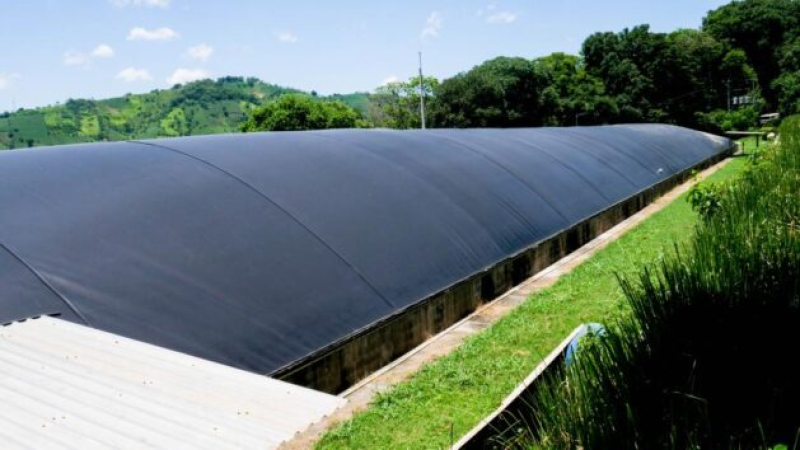- Trump considering military options on Greenland; Europe rejects |
- Fertiliser crunch threatens Kushtia’s onion boom despite high prices |
- Security Council Divided on United States' Venezuela Action |
- Over 1.53m voters register for postal balloting: Shafiqul Alam |
Biogas Helps Reduce Poultry Waste Pollution in El Salvador

The biodigester at the Renig plant in Jayaque, southwestern El Salvador, processes 200,000 tons of chicken manure annually from the farms of the company El Granjero. This serves as the raw material for producing biogas, which is used to generate electricity injected into the national grid.
Still in its early stages and with few participants, the poultry sector in El Salvador is taking small steps toward environmentally sustainable production by using biological waste to generate biogas—and, in turn, electricity—benefiting the environment, communities, and farms alike.
El Granjero, the second-largest egg-producing company in the country with over one million chickens across eight farms, created the subsidiary Renig in 2017 after investing US$2.5 million to build a biogas plant.
“I thought biodigesters were the most suitable because you solve the environmental problem right away—and there’s the possibility of being profitable,” said Bernhard Waase, director of Renig.
By 2018, the company began processing 200,000 tons of chicken manure and organic waste annually. This waste serves as the raw material for biogas, which is then used to generate electricity injected into the national power grid.
“Back around 2010 or 2012, we discussed what to do with all the chicken manure because the way it was handled—both in El Salvador and globally—was simply dumping it in the open,” Waase recalled. The facility is located in La Labor, within the district of Jayaque, in the southwestern department of La Libertad.
Five of El Granjero’s eight egg-producing farms are located in this rural settlement.
Poultry-related environmental pollution has caused tension with nearby rural communities, especially as farms expanded into populated areas over time, such as El Granjero, which was established in 1968.
“When the company was founded, there wasn’t a single house nearby—it was completely uninhabited,” said Waase. “But the pollution problem persisted.”
He reiterated the potential of biodigesters to both solve pollution and possibly turn a profit.
The country’s poultry industry produces around 1.2 billion eggs and 342 million pounds of chicken meat annually, according to the Salvadoran Poultry Association. Despite this output, the sector contributes only 0.79% to the national GDP, though it accounts for 16% of the agricultural GDP.
Few companies have opted to manage biological waste sustainably. One exception is Grupo Campestre, a major chicken producer that invested US$7 million in a biogas plant to process 40,000 tons of waste from its farms, processing plant, and fried chicken restaurants.
Biogas still makes up a tiny share of El Salvador’s energy mix—so small, in fact, that it doesn’t appear in official figures. The national energy matrix is dominated by hydropower (33.7%), geothermal (23%), and natural gas (16%). Solar provides 8.5%, and wind just 2.1%.
Nevertheless, the country has shown increased interest in clean, renewable energy, which now comprises 70% of its energy mix, according to government data.
Waase noted that producing electricity from biogas is both expensive and complex, requiring major investments and specialised staff.
“It’s costly—equipment, operations, training. It’s not like solar. That’s child’s play: get land, install panels, connect them, and you’re done. Biogas is far more complicated,” he said.
The complexity of biogas production stems from its reliance on bacteria—living organisms that can behave unpredictably. Melissa Ruiz, who oversees the digester and secondary processes, explained that the bacteria can fall “ill” and must be managed carefully.
“The digester is like a stomach. The bacteria react to what we feed them—just like us. An unbalanced diet can make us feel sick; it’s the same for the digester,” she said.
After committing to biogas, El Granjero worked on the technical, operational, and financial aspects of the Renig plant, which includes a 92-meter-long, 17-meter-wide, 5-meter-deep biodigester with a capacity of 5,300 cubic meters.
This is the heart of the plant. Here, bacteria break down chicken manure to produce methane, which fuels two engines, each capable of generating 425 kilowatts of electricity.
If not captured, methane would escape into the atmosphere, contributing to global warming. According to the UN Environment Programme, methane has 80 times the warming potential of carbon dioxide and is a major factor in the formation of ground-level ozone, which causes 1 million premature deaths annually.
Renig’s biodigester began producing biogas in 2018, but electricity generation only started in 2021, when the company won a government tender for renewable energy production.
During the interim, the gas was flared using a US$40,000 combustion torch to prevent emissions.
“This torch literally burned money,” Waase said. “Since February 2021, it hasn’t been lit—we’re generating energy now.”
In 2019, Renig secured a contract to supply 0.85 megawatts to the national grid—a modest amount, but a key milestone. By comparison, AES El Salvador’s Nejapa biogas plant, built in 2011, produces six megawatts and cost US$58 million.
Waase said that while the plant has been a clear environmental success, the financial returns have been less promising.
“Environmentally, it’s been a total success. Financially, it’s much more complicated. We’ve never lost money, but we’re far from the returns we had projected,” he admitted.

